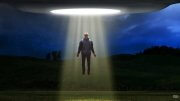I’m no psychologist, but I’ll tell you this. If AI comes to dominate the cultural landscape, human beings will lose their minds. Joe Allen
The content below and imagery are quite bizarre, but if we continue on this transhumanism path, they well may be an example of the real hell society is headed for. Unless the individual becomes independent from this “machine”, you will be assimilated into it without knowing.
The following from Joe Allen should be a wake up call to our readers.
Imagine a world where every image has been sifted through the Machine
David Cronenberg is one of the freakiest film-makers of all time. His vision is perverted and disgusting—but always heavy, and always insightful. His movies evoke biomedical horrors, where machines look like pulsating organs, and organisms look like slimy machines. The vibe is a high brow barf-fest.
You’ve got the exploding head in Scanners. You’ve got the rapey homo-caterpillar in Naked Lunch. You’ve got those butthole-looking bio-ports in eXistenZ. You’ve got plastic-eating, trans-organ-harvesting narcissists in the new Crimes of the Future. Not exactly date night material.
By the end of each movie, you can’t imagine how the next would be more repulsive. And by the end of the next one, you realize you were sorely mistaken.
As it turns out, things can always get worse. Last weekend, Cronenberg’s brilliant cinematography was siphoned up from the Internet, data-mined to the last frame, broken down into statistical models, and refashioned into a film that never existed.
“David Cronenberg’s Galaxy of Flesh (1985)”
These computer-generated images bother me for two reasons.
First, they really do look like something Cronenberg would make. Setting aside my hatred for this dehumanizing technology, I’ll admit some scenes are as good as anything he ever did. They even smell like a Cronenberg movie.
More troubling, though, is that these hellish scenes of malnourished cyborgs and brittle robots were literally dreamt up by a machine. They are the mathematical distillation of a subconscious mind.
Exposed organs. Insectoid hybrids. Artificial archetypes. The electric Id.
It’s all there.
Of course, it was some mask-obsessed Covidian who did this. Who else? Using a new AI image generator, Midjourney, ad-maker and music video director Keith Schofield became a prodigious “prompt engineer.” Each image was cranked out in the blink of an eye.
This is all part of the new normal. Text-to-image AI art is filling cyberspace so fast, it’ll soon be all we see. Before you know it, these derivative images will be on every ad and book cover. People won’t see anything that hasn’t been sifted through the Machine.
Midjourney. DALL·E 2. Stable Diffusion. Imagen.
This software is like a genie who moonlights as a graphic artist. He may be unoriginal, but he grants unlimited wishes. The user just rubs the magic lamp, makes a wish, and the Machine spits out another image. Of course, each one is derived from the vast catalog of previous human efforts, which amounts to stealing and repurposing artwork at scale.
These AI remixes are picking up where the DJ left off. But you know, the original artists can always learn to code. Or engineer prompts. Or something.
Intoxicated by this creative destruction, Shofield generated over two hundred images in no time. Naturally, long-time Cronenberg fans are furious—partly because the pics look so cool.
Although Shofield doesn’t reveal what prompts he used, you could imagine a text string like “cronenberg with alien meat pile buffet.” Or maybe “cronenberg with castrated robot lovers, ribs like worms.”
It’s just a guess. What do I know? I’m not some “prompt engineer.”
Before passing judgment, though, let’s roll through a few striking scenes. Keep in mind this parallel universe never existed until a computer drifted off into digital nightmares. (I’ll add a little dialogue for context.)
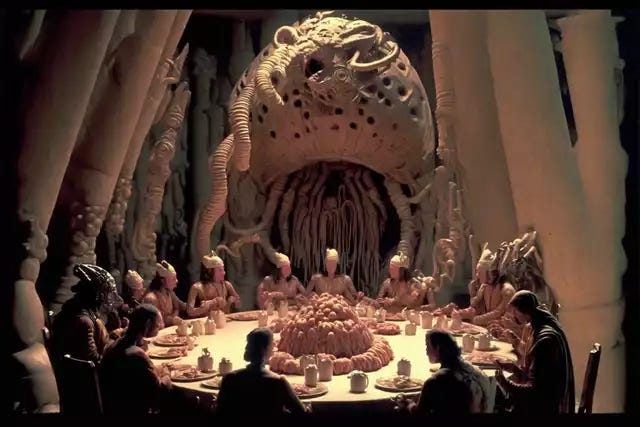
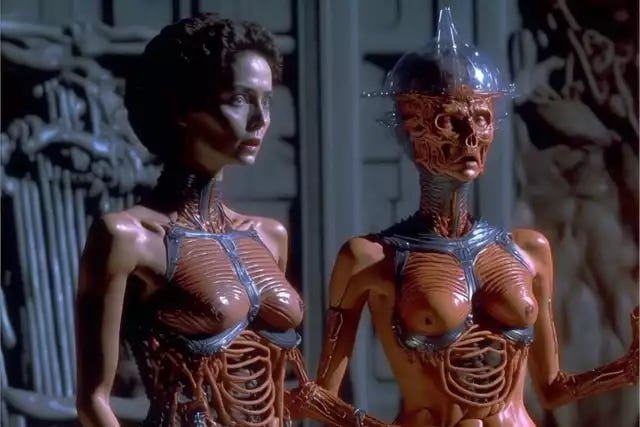

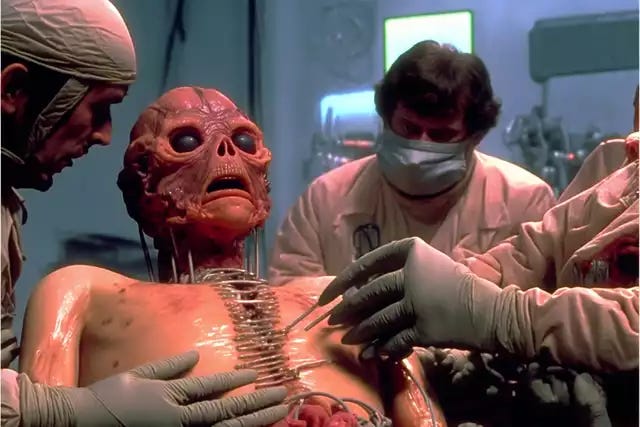
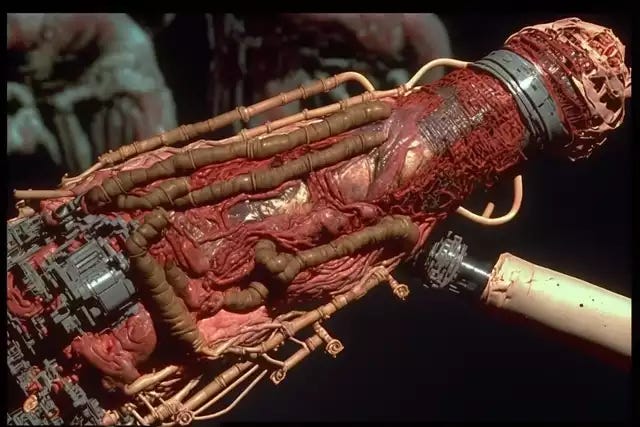
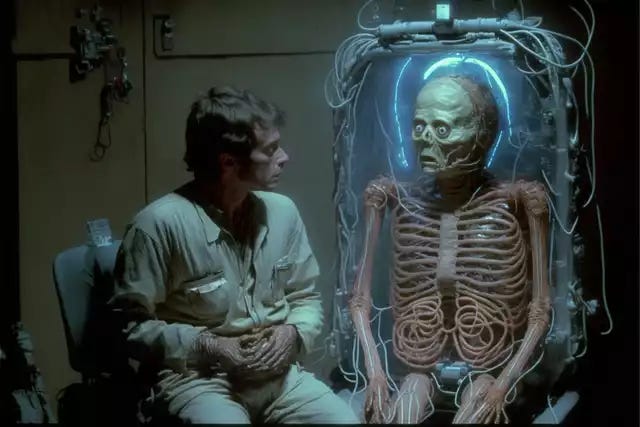



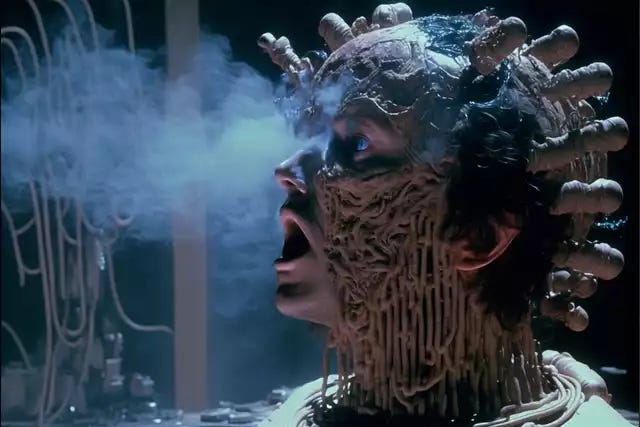

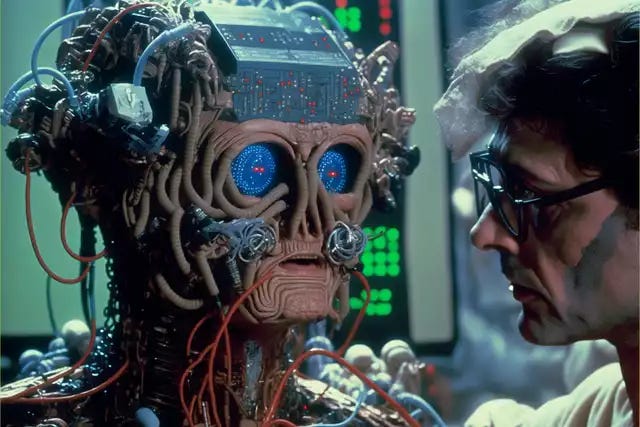
The hokey effects look great on VHS, but my favorite Cronenberg film is his subdued historical drama, A Dangerous Method. There’s no oily surrealism or mutilated humanoids. It’s based on the true story of Sigmund Freud and his protégé Carl Jung. The action centers on their psychotherapeutic love triangle with a super hot, if hysterical patient, Sabina Spielrein.
I saw it at an art house theater in Nashville, Tenn, some twelve years ago. Beer was cheap in those days. Some movies were still shot on film and slightly crooked teeth were sexy. Shrinks were still horny old dudes and nobody gave a damn one way or another.
So far as I remember, the only gross scene involved a brief glimpse of some bloody sheets. The rest was just talk therapy and dream analysis, with a little kink here and there. It was an elegant film to make ya think.
Freud thought dreams released our repressed desires. Jung believed they tapped into a spiritual dimension. Throughout his bizarre career, Cronenberg managed to capture both angles.
Thinking back on all three paradigms—the Id and Super Ego; the Collective Unconscious; the weird phallic pustules—what do these new, AI-generated images even mean? Are the symbols potent? Whose soul do they express?
What does it mean for a machine to dream? What happens when our minds brim with synthetic fantasies?
I’m no psychologist, but I’ll tell you this. If AI comes to dominate the cultural landscape, human beings will lose their minds.


